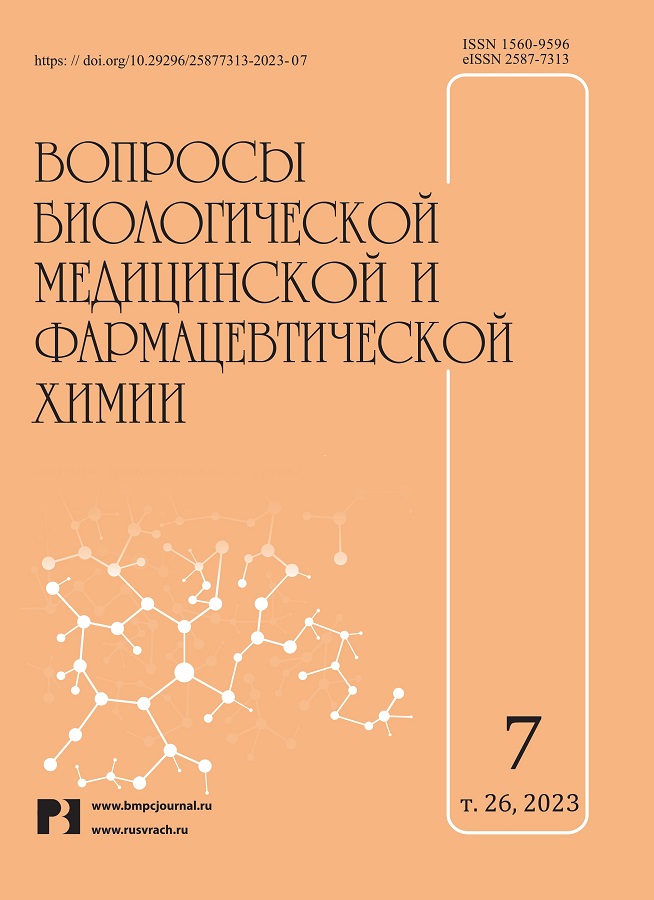Изучение влияния модификации структуры нового производного хиназолин–4(3h)–она на синтазу жирных кислот (FAS) Mycobacterium
- Авторы: Старикова А.А.1, Самотруева М.А.1, Золотарева Н.В.2, Цибизова А.А.1, Мережкина Д.В.3, Озеров А.А.4
-
Учреждения:
- ФГБОУ ВО Астраханский ГМУ Минздрава России
- Астраханский государственный университет имени В.Н. Татищева
- ФГБОУ ВО Вологоградский ГМУ Минздрава России
- ФГБОУ ВО Волгоградский ГМУ Минздрава России
- Выпуск: Том 26, № 7 (2023)
- Страницы: 34-40
- Раздел: Фармацевтическая химия
- URL: https://journals.eco-vector.com/1560-9596/article/view/568659
- DOI: https://doi.org/10.29296/25877313-2023-07-05
- ID: 568659
Цитировать
Полный текст
Аннотация
Актуальность. Туберкулез остается одной из основных причин инвалидизации и смертности от инфекционных заболеваний во всем мире. Обнаружение фенотипически толерантных субпопуляций персистеров патогена поставило под сомнение возможности известных противотуберкулезных лекарственных средств. В связи с этим поиск и разработка новых эффективных противотуберкулезных препаратов является важным направлением развития современной фармакологии. В настоящее время актуально рассмотрение веществ хиназолиновой природы в качестве антимикробных средств, проявляющих противотуберкулезную активность.
Цель работы – компьютерное моделирование взаимодействия новых производных хиназолин–4(3Н)–она с NAD(H) с целью прогнозирования возможности влияния на синтазу жирных кислот (FAS) Mycobacterium.
Материал и методы. Моделирование межмолекулярных комплексов в системе взаимодействия новых производных хиназолин-4(3Н)–она – VMA–17–04 и VMA–13–05 с окисленной формой NAD+ проведено с использованием квантово-химического полуэмпирического PM7-метода, реализованного в программе MOPAC 2016.
Результаты и выводы. Производное VMA–13–05, находясь в стабильной конформации I, образует аддукт с NAD+, имеющий оптимальные энергетические характеристики. Данное взаимодействие может быть рассмотрено как один из этапов биохимического пути подавления активности синтазы FAS, принимающей участие в синтезе миколовых кислот, а также может приводить к гибели клеток Mycobacterium.
Полный текст
Об авторах
А. А. Старикова
ФГБОУ ВО Астраханский ГМУ Минздрава России
Автор, ответственный за переписку.
Email: alhimik.83@mail.ru
ст. преподаватель, кафедра химии фармацевтического факультета
Россия, АстраханьМ. А. Самотруева
ФГБОУ ВО Астраханский ГМУ Минздрава России
Email: ms1506@mail.ru
д.м.н., профессор, зав. кафедрой фармакогнозии, фармацевтической технологии и биотехнологии
Россия, АстраханьН. В. Золотарева
Астраханский государственный университет имени В.Н. Татищева
Email: zoloto.chem@mail.ru
к.т.н., доцент, доцент кафедры аналитической и физической химии
Россия, АстраханьА. А. Цибизова
ФГБОУ ВО Астраханский ГМУ Минздрава России
Email: sasha3633@yandex.ru
к.фарм.н., доцент кафедры фармакогнозии, фармацевтической технологии и биотехнологии
Россия, АстраханьД. В. Мережкина
ФГБОУ ВО Вологоградский ГМУ Минздрава России
Email: merezhkinad@mail.ru
аспирант, кафедра фармацевтической и токсикологической химии
Россия, ВолгоградА. А. Озеров
ФГБОУ ВО Волгоградский ГМУ Минздрава России
Email: prof_ozerov@yahoo.com
д.х.н., профессор, зав. кафедрой фармацевтической и токсикологической химии
Россия, ВолгоградСписок литературы
- Rohde K.H., Sorci L. The Prospective Synergy of Antitubercular Drugs with NAD Biosynthesis Inhibitors. Frontiers in Microbiology. 2021; 11: 1–9. doi: 10.3389/fmicb.2020.634640.
- Isel A. E. J., Van der leyden J., Steenakers H. Repurposing drugs derived from nucleosides and nucleotides as antibiotics and biofilm inhibitors. Journal of Antimicrobial Chemotherapy. 2017; 72(8): 21562170. doi: 10.1093/jac/dkx151.
- Ratnatunga K.N., Lutsky V., K uoc A., Dolan D.L., Ed D.V., Phil M., Bel S.K., Thomson R.M. and Miles J.J. The growth of non-tuberculosis mycobacterial lung diseases. The front. Immunal. 2020; 11: 303. doi: 10.3389/fimmy.20.003.
- Gas C. Mycobacterium tuberculosis and lipids: understanding the molecular mechanisms from persistence to virulence. J. Res. Med. Sci. 2018; 23: 63.
- Jeffrey North E., Jackson M., E. Lee R. New approaches to targeting the pathway of mycolic acid biosynthesis for the development of anti-tuberculosis drugs. Modern Pharmaceutical Design. 2014; 20(27): 43574378.
- Rudraraja R.S., Daher S.S., Gallardo-Macias R., Van H., Neidich M.B., Freundlich J.S. Mycobacterium tuberculosis KasA as a drug target: structure-based inhibitor design. The anterior cells infect the microbiota. 2022; 12: 1008213. doi: 10.3389/FCIMB.2022.1008213.
- Jayaraman M., Rajendra S.K., Ramadas K. Structural understanding of conformational dynamics of inactive site mutations in KasA: Mycobacterium tuberculosis target protein. Gen. 2019; 720: 144082. doi: 10.1016/j.gene.2019.144082.
- Wang J., Ye H., Yang H., Cai Yu., Wang S., Tan J., Sachdeva M., Qian Yu., Hu V., Leeds J.A., Yuan Yu. Discovery of new antibiotics as covalent inhibitors of fatty acid synthesis. ACS Chem Biol. 2020; 15(7): 18261834. doi: 10.1021/acschembio.9b00982
- Hassan M.R., Alsayari A.A., Fahurji B.Z., Molla M.H.R., Asseri A.H., Sumon M.A.A., Park M.N., Ahammad F., Kim B. Application of mathematical modeling and computational tools in the modern process of designing and developing medicines. Molecules. 2022; 27: 4169. https://doi.org/ 10.3390/molecules27134169.
- MOPAC2016, James J., Stewart, Stewart Computational Chemistry, Colorado Springs, Colorado, Colorado, USA, http://OpenMOPAC.net (2016).









